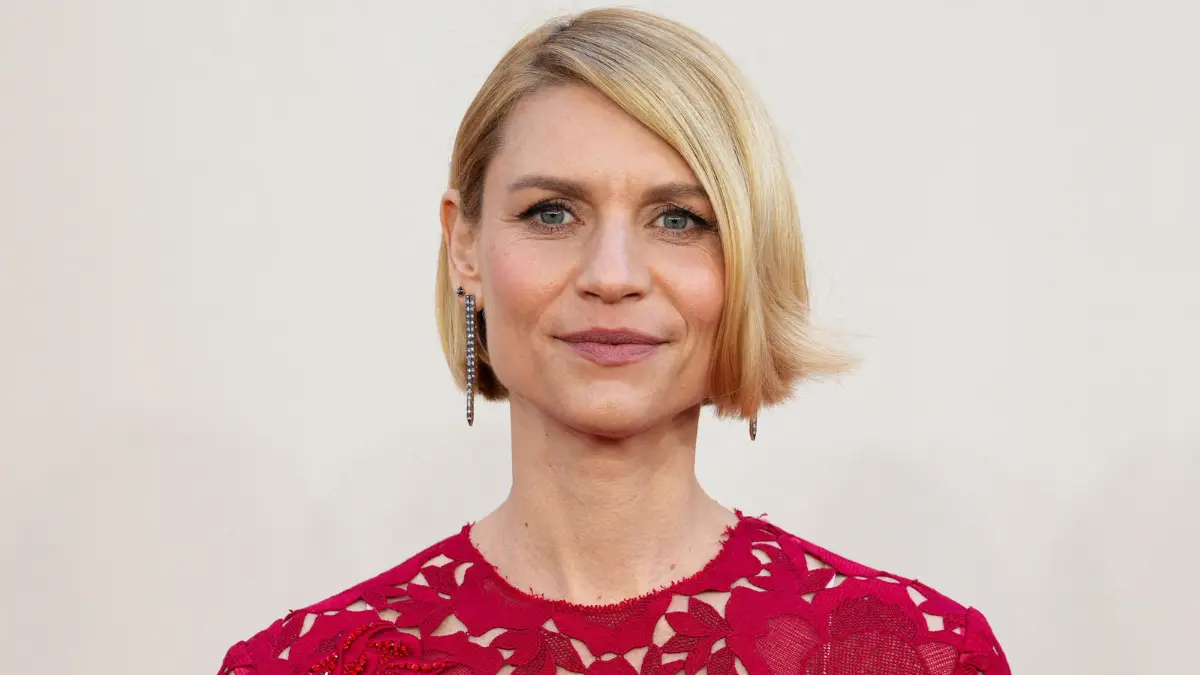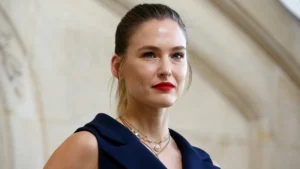If you were a teen in the ’90s, you probably remember Angela Chase’s crimson hair and deadpan eye-rolls in My So-Called Life. Claire Danes didn’t just play a character — she became a cultural mirror for a generation.
Fast-forward nearly three decades. She’s no longer just the face of ’90s angst. She’s the Emmy-winning powerhouse of Homeland, walking red carpets with the same quiet confidence that once fueled Angela’s diary entries.
What makes Danes remarkable isn’t just their longevity. It’s her ability to bridge eras of storytelling — from cult teen drama to political thrillers that defined post-9/11 television.
In short, Claire Danes remains relevant because she’s bridged the teen culture of the ’90s with critically acclaimed adult roles, making her both nostalgic and current.
And that rare balance — nostalgic yet evolving — is why audiences still lean in when her name flashes on the screen.
Claire Danes’ Early Years: From Manhattan Childhood to Stage Dreams
Growing up in New York City’s artistic family roots
Claire Danes’ childhood in SoHo looked nothing like the suburban backdrops of her future teen dramas. She grew up in a loft where canvases leaned against walls and photography gear filled corners.
Her mother, Carla Danes, worked as a painter and artist. Her father, Christopher Danes, pursued photography and design. Creativity wasn’t an extracurricular in the Danes’ household — it was the family currency.
Living in New York City during the 1980s meant exposure to a raw, evolving art scene. Graffiti, gallery openings, and street performers surrounded her. As critic Sarah Boxer once noted, “Kids who grow up in Manhattan breathe art before they ever study it.”
This constant immersion gave Danes a sense that performance was inevitable, not optional. Her home doubled as a workshop where imagination was encouraged, laying the foundation for the emotional intensity that would define her screen presence.
Born into New York’s art scene, Claire Danes’ childhood home doubled as a creative hub where performance felt inevitable.
Ballet, acting classes, and the spark of performance at age 6
Before cameras ever found her, Claire Danes was moving to music. At just six years old, she enrolled in ballet and modern dance, letting rhythm guide her small frame across rehearsal floors.
That discipline quickly expanded into acting classes, where she discovered another stage — one where words mattered as much as movement. She trained at institutions like the Lee Strasberg Theatre & Film Institute, places known for shaping some of Hollywood’s most emotionally raw performers.
Teachers noticed her intensity early. While other kids played at roles, Danes leaned in, finding the feeling beneath the lines. That instinct carried into her teenage performances, where audiences would later praise her ability to portray vulnerability with unusual depth.
Her early training didn’t just teach her steps or dialogue. It set the foundation for an actress whose emotional intensity became her trademark, visible from My So-Called Life to Homeland.
Stepping Into the Spotlight: From Student to Rising Star
A teenage debut on Law & Order and short films
Before Hollywood came calling, Claire Danes landed a blink-and-you ”ll-miss-it role on Law & Order in 1992. At just 13, she played a troubled teen in a single episode.
The appearance was brief, but fans now treat it like a hidden gem. Clips circulate online, with viewers marveling at how much of her trademark intensity was already visible.
Not long after, she worked on the indie short Dreams of Love. Though little-known, it showed her willingness to take risks outside the mainstream, even as a teenager.
These early projects weren’t glamorous, but they mattered. They revealed a teen actress unafraid of raw material, setting the stage for her breakout in My So-Called Life.
Before stardom, Claire Danes’ earliest role was a brief Law & Order appearance at age 13.
Balancing studies at Yale with an acting career
At the height of her rising fame, Claire Danes stepped away from Hollywood to pursue an English degree at Yale University. It was a bold decision for a young actress already in demand.
Her choice meant turning down high-profile scripts, a sacrifice that drew mixed reactions. Some critics questioned the pause, while others praised her for prioritizing education over constant exposure.
Danes studied literature and philosophy, disciplines that sharpened her understanding of complex characters. This intellectual grounding later informed her nuanced roles in projects like Temple Grandin.
She didn’t finish the degree, ultimately returning to acting. Still, the experience marked her as an artist willing to trade momentum for meaning, setting her apart in an industry often driven by speed over depth.
My So-Called Breakthrough: The Role That Defined Claire Danes
Angela Chase in My So-Called Life: A teen icon is born
In 1994, teen television looked different. Grunge ruled the radio, MTV defined pop culture, and then came Angela Chase. Claire Danes, just 15, gave life to a character who felt achingly real.
Angela’s messy hair, oversized flannels, and restless voice weren’t just wardrobe choices. They captured the uncertainty of adolescence in a way glossy teen dramas rarely did. Fans didn’t just watch her — they saw themselves.
The series lasted only 19 episodes, but its influence hasn’t faded. Rolling Stone later wrote that My So-Called Life “didn’t just depict adolescence — it embodied it, in all its contradictions.”
That authenticity earned Danes a Golden Globe in 1995, an extraordinary feat for a teenager still finding her footing. Critics praised her vulnerability, while viewers embraced her as the voice of their generation.
Claire Danes wasn’t just acting. With Angela Chase she became a cultural touchstone for every teen navigating the awkward edges of growing up.
How one season made her a generational voice
My So-Called Life ended after just 19 episodes, but its short run didn’t erase its impact. Instead, it became a cult teen show that fans still revisit three decades later.
Online, Reddit nostalgia threads and fan blogs keep Angela Chase alive. Viewers trade stories of watching it on VHS, describing how the show felt more like a diary than a scripted drama.
Cultural critics underline why it mattered. As one wrote, “Angela Chase defined the introspective teen before Dawson’s Creek ever aired.” That distinction placed Claire Danes at the forefront of a new kind of storytelling.
The series spoke to isolation, identity, and the messy search for belonging. Those themes made Danes more than a performer — they turned her into a generational voice.
For many, 19 episodes were enough. They proved that a story doesn’t have to last long to leave a lasting cultural imprint.
Behind the Fortune: Claire Danes’ Net Worth & Income Sources
Homeland paychecks and Hollywood’s top-tier salaries
When Homeland became a global hit, Claire Danes’ salary skyrocketed. According to Forbes, she earned up to $450,000 per episode, placing her among the highest-paid actresses on television.
That paycheck pushed her career earnings into the tens of millions. As of 2025, industry estimates place her net worth around $35 million, built largely from television work and select film roles.
To put her income in perspective, here’s how Danes compared with her peers during peak years:
- Claire Danes (Homeland) — $450k per episode
- Julianna Margulies (The Good Wife) — $180k per episode
- Viola Davis (How to Get Away with Murder) — $250k per episode
The numbers underline just how central Danes were to Homeland’s success. Networks were willing to pay top-tier salaries to keep her in the role of Carrie Mathison.
At her peak, Claire Danes earned $450,000 per episode of Homeland, making her one of TV’s highest-paid actresses.
Comparing the Danes’ wealth with contemporaries
Measured against her peers, Claire Danes’ wealth reflects both success and industry inequality. While her Homeland salary put her in elite company, the broader gender pay gap still loomed.
Vanity Fair reported that even top-tier women in television often earned less than their male counterparts in similar prestige roles. Danes’ income was strong, but far from the blockbuster contracts of actors like Kevin Spacey or Jon Hamm at the time.
By 2025, estimates suggest she will remain wealthy, with a fortune of around $35 million. Still, as Forbes noted, “She’s wealthy, but not billionaire-famous like some peers.”
Compared with contemporaries such as Julianna Margulies or Viola Davis, Danes consistently ranked higher in per-episode pay. Yet the contrast highlights Hollywood’s ongoing debates about equity, visibility, and how women’s talent is valued in long-running television.
Matters of the Heart: Claire Danes’ Relationships & Love Stories
From Leonardo DiCaprio whispers to Ben Lee romance
Claire Danes’ dating history often drew headlines, especially during the Romeo + Juliet era. Rumors swirled about a romance with Leonardo DiCaprio. Reports suggest, but never confirm, that the on-screen chemistry spilled off set.
After that period of speculation, she entered a long-term relationship with Australian singer Ben Lee. The pair dated for nearly six years, often appearing together at cultural events in New York and Los Angeles.
Their romance was quieter than the Hollywood gossip cycle. Fans recall interviews where Danes described Lee as supportive and grounded, offering stability at a time when her career was accelerating.
Though the relationship eventually ended, it marked a chapter where Danes embraced love outside Hollywood’s usual spotlight. This period also showed how she navigated public curiosity while maintaining a sense of privacy.
Marriage to Hugh Dancy: A Hollywood partnership built on privacy
In 2009, Claire Danes married British actor Hugh Dancy, marking the start of one of Hollywood’s quieter love stories. The ceremony in France was intimate, a sharp contrast to typical celebrity extravagance.
Together, they built a family life that values privacy. The couple has two children and splits time between New York City and occasional work locations abroad. Unlike many in the industry, they’ve kept their family largely out of the spotlight.
In interviews, Danes has spoken about the balance they’ve created. She once noted that Dancy’s steady presence allowed her to pursue demanding roles while still prioritizing motherhood.
Their marriage has endured through career highs and long filming schedules. In an industry where relationships often dissolve under pressure, Danes and Dancy’s partnership stands out as rare stability — a testament to shared values and mutual respect.
Life Beyond the Camera: Passions, Causes, and Advocacy
Artistic hobbies, literature, and personal passions
Away from the camera, Claire Danes has always nurtured her artistic side. She trained in modern dance as a child and still finds joy in movement, often crediting it as a form of grounding.
Books remain a constant in her life. Her time at Yale deepened a love for literature, and she’s spoken about using reading to recharge between projects.
Danes also leans into quieter hobbies. She has mentioned knitting as a calming pastime and has dabbled in learning new languages, reflecting her curiosity beyond Hollywood.
These passions give her a balance many celebrities lack. They show Danes not only as an actress but as someone who values creative exploration outside the spotlight.
Supporting women in film and mental health advocacy
Beyond her acting career, Claire Danes has used her platform for advocacy. She’s lent support to organizations that champion women in film, encouraging greater visibility for female directors and writers in Hollywood.
Danes has also spoken openly about the importance of mental health awareness. She’s participated in initiatives connected to the National Alliance on Mental Illness (NAMI) and highlighted the need for accessible resources.
Her advocacy isn’t loud or performative. Instead, it reflects steady engagement with causes that align with her values. By combining industry influence with social responsibility, Danes shows how philanthropy and artistry can coexist in meaningful ways.
This quieter but consistent commitment sets her apart. Competitors often focus only on her acting, while her philanthropic footprint reveals a deeper legacy.
Family Ties and Supportive Inner Circle
Parents’ artistic influence and ongoing support
Claire Danes’ parents remained steady anchors throughout her career. Growing up with SoHo artist parents gave her both perspective and grounding when fame arrived early.
Her mother, Carla Danes, wasn’t just an inspiration but also hands-on. She designed costumes for some of Claire’s early performances, shaping both her creativity and confidence.
Her father, Christopher Danes, contributed through photography and design, reminding her to see the world with curiosity and discipline.
Even as her career accelerated, their presence provided stability. That balance of artistic freedom and family support allowed Danes to navigate Hollywood without losing her foundation in creativity and authenticity.
Raising two children with Hugh Dancy in New York
Claire Danes and Hugh Dancy have chosen New York City as the place to raise their two children. Unlike the Hollywood spotlight, the city offers them both vibrancy and relative anonymity.
In interviews, Danes has emphasized the importance of normalcy. She’s spoken about wanting her kids to grow up with stability, surrounded by real-world experiences rather than the constant attention of Los Angeles.
Family life in New York allows them to balance demanding careers with parenting. School runs, park outings, and community life keep their household grounded.
This commitment to privacy shows another side of the Danes. Beyond the awards and red carpets, she prioritizes family life over fame, proving that success can coexist with simplicity.
Challenges, Criticism, and Public Image Over the Years
The Billy Crudup affair and tabloid scrutiny
In 2003, Claire Danes became the center of a tabloid storm. Reports claimed she began a relationship with actor Billy Crudup, who at the time was expecting a child with Mary-Louise Parker.
The news ignited relentless coverage. Headlines painted Danes as a scandal figure, overshadowing her professional work. Confirmed in tabloids but intensely debated, the story fueled months of speculation and criticism.
For an actress celebrated for authenticity, the controversy was a sharp contrast. Fans and critics alike debated whether her personal life should affect her reputation on screen.
Though deeply invasive, the episode revealed how quickly Hollywood narratives shift. What lingered wasn’t only the relationship itself, but the scrutiny women face in public life, often harsher than their male counterparts.
Rebuilding reputation with Emmy-winning resilience
After the tabloid storm, Claire Danes shifted the focus back to her craft. In 2010, her performance in Temple Grandin earned critical acclaim and an Emmy, praised for its depth and authenticity.
Soon after, she redefined her career with Homeland. As Carrie Mathison, she delivered one of television’s most complex portrayals of mental health and political intrigue, collecting two more Emmys.
Critics noted how she rebuilt her image not through statements, but through relentless dedication to storytelling. Craft, not controversy, became the headline again.
Fans also play a role in reshaping her legacy. As one viral post put it, “Twitter still debates if the scandal hurt or helped her resilience.” What’s clear is that the Danes’ comeback proved talent can outlast tabloid noise.
Standing Among Peers: Comparisons and Unique Edge
How Danes’ trajectory contrasts with Natalie Portman & Claire Foy
Claire Danes, Natalie Portman, and Claire Foy share reputations for intelligence-driven performances, yet their career paths diverge in telling ways.
Portman embraced blockbuster visibility, from Star Wars to Thor, while still balancing acclaimed indie projects. Foy became globally recognized through The Crown, tying her name to royalty and prestige television.
Danes, by contrast, leaned into roles defined by emotional intensity rather than spectacle. From Angela Chase to Carrie Mathison, she chose characters rooted in vulnerability and complexity.
This path highlighted substance over franchise fame. While Portman and Foy reached wider global audiences, Danes built a legacy anchored in raw, intimate storytelling — a lane fewer stars commit to.
Emotional intensity is her signature acting style
Few actresses are as linked to emotional intensity as Claire Danes. Film historians often note her ability to inhabit vulnerability, delivering performances that feel raw rather than rehearsed.
Her crying scenes, from Romeo + Juliet to Homeland, became a defining trait. Viewers praised the authenticity, but they also turned it into a cultural phenomenon.
Online, the infamous “Claire Danes crying face” became a meme — shared with equal parts humor and admiration. Rather than diminishing her craft, the meme highlighted how deeply audiences connected with her portrayals.
What sets Danes apart is that these moments never feel forced. Her emotional transparency became a signature style, one that continues to resonate across generations of viewers.
Achievements That Secured Claire Danes’ Legacy
Three Emmy Awards for Homeland and beyond
Claire Danes’s awards cabinet reflects her staying power. She has won three Primetime Emmy Awards for her portrayal of Carrie Mathison in Homeland, cementing her place among television’s elite.
Those Emmys joined a Golden Globe she earned as a teenager for My So-Called Life and additional Golden Globes for Temple Grandin and Homeland. Each honor underscored her range — from a troubled teen to a groundbreaking CIA officer.

Critics often cite these wins as proof of her consistency. Unlike actors tied to one era, Danes collected awards across decades, showing both growth and resilience.
Her Homeland success, in particular, placed her alongside TV icons such as Julianna Margulies and Edie Falco. Awards didn’t just validate her craft — they built her reputation as one of the most reliable dramatic performers of her generation.
Cultural impact from Romeo + Juliet to Homeland
In 1996, Baz Luhrmann’s Romeo + Juliet introduced Claire Danes to a global audience. As Juliet, she became the face of tragic young love for an entire generation of teens.
That performance, paired with Leonardo DiCaprio’s Romeo, turned her into a cultural icon. Even today, clips from the film circulate on TikTok and YouTube, reminding viewers of her timeless appeal.
Two decades later, Homeland reintroduced Danes to a different audience. As Carrie Mathison, she represented the complexities of post-9/11 America, blending vulnerability with steely resolve.
Fans still highlight this dual legacy online. One Reddit user put it simply: “She gave us the Juliet of the ’90s and the Carrie of the 2010s. That’s range.”
Fun Facts About Claire Danes
Fluent in French and a trained modern dancer
Beyond acting, Claire Danes speaks fluent French and has trained extensively in modern dance. These skills shaped both her confidence and physical presence on screen.
Her dance background gave her the expressive body language seen in roles like Romeo + Juliet. Meanwhile, her language skills reflect the curiosity and discipline that define her off-screen life.
Turned down iconic roles (including Titanic’s Rose)
At the height of her rising fame, Claire Danes declined the role of Rose in Titanic. She later admitted she wasn’t ready for another high-profile teen romance after Romeo + Juliet.
This decision became one of Hollywood’s great “what-ifs.” Instead of chasing blockbusters, Danes chose roles that favored depth over spectacle, shaping a career defined by resilience and craft.
Claire Danes’ Legacy of Talent and Resilience
From the grunge-era angst of the 1990s to the Emmy-winning prestige of the 2020s, Claire Danes has built a career defined by emotional depth and staying power. She has moved seamlessly from Angela Chase’s restless teenage voice to Carrie Mathison’s complex brilliance, bridging decades of cultural change without losing her authenticity.
Her story isn’t about overnight stardom or blockbuster fame. It’s about choosing roles that mattered, even when they carried risk. As she once reflected, “I’m interested in characters who are messy and human.” That philosophy has guided her, keeping her relevant while many of her peers faded.
The Claire Danes legacy rests on resilience, artistry, and a refusal to compromise substance for spectacle. With future projects still ahead, she remains one of Hollywood’s most respected yet perhaps underrated performers.
FAQs About Claire Danes
What role made Claire Danes famous?
Is Claire Danes married to Hugh Dancy?
How much did Claire Danes earn from Homeland?
Did Claire Danes almost star in Titanic?
Mohit Wagh is the co-founder and feature writer at The Graval, bringing 10 years of experience in celebrity and pop culture reporting. He crafts engaging, fact-driven stories that capture the pulse of what’s trending across Hollywood and beyond.





9 thoughts on “Claire Danes Biography: Age, Early Life, Career Highlights, and Net Worth”